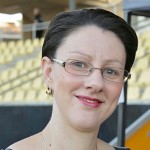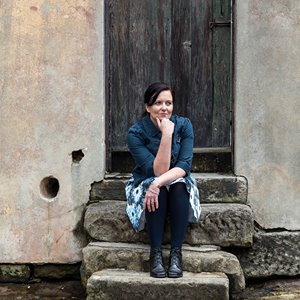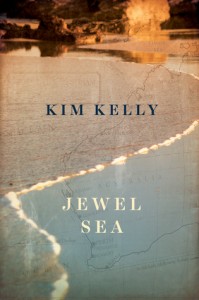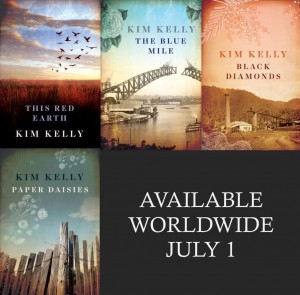Welcome to Sunday Spotlight. Today we welcome Kim Kelly, who is celebrating 10 years since the publication of her first novel, Black Diamonds. Beautifully repackaged, Black Diamonds is being relaunched on 1 July 2017, along with all her earlier novels, This Red Earth, The Blue Mile, and Paper Daisies. Her most recent release, Jewel Sea, came out in September of last year.
When did you start writing and what was the catalyst?
I’ve always written, always been a scribbler of stories and poems since childhood, but up until my 30s I was crushingly shy about it. In my late 20s, as a young mum, I lucked out landing a job with Random House and through editing other authors’ work I was not only able to study writing intensively, but little by little I also gained the confidence to begin taking a punt on myself. If all these wonderful and often crushingly shy authors could do it, so could I. It was an amazing apprenticeship that made me dare to have a go myself. Back in 2004 I took three months off work and secretly tapped out my first manuscript. And I lucked out again, as that manuscript, Black Diamonds, was published in 2007.
How many novels have you written and published?
I’ve now had six works of historical fiction published: Black Diamonds, This Red Earth, The Blue Mile, Paper Daisies, Wild Chicory and Jewel Sea. I’ve also had a non-fiction book published, having written Dangerous Days: A Digger’s Great Escape for the marvellous WWII veteran and Rat of Tobruk, Ernest Brough. I have two completed manuscripts with my agent right now and am presently belting out the first draft of another. Let’s just say, I have red shoes on the writing brain – can’t stop me!
How long on average does it take you to write a book?
My first drafts tend to pour out in a rush – usually about three months of fairly frantic writing, though that time seems to be shortening with each novel. These first drafts are invariably messy and a little too high-pitched and breathless in tone, so I’ll spend a lot of time – perhaps six months or a year – refining voice, deepening place, sharpening language, dialogue and descriptions.
How has being Australian AND a woman impacted on your writing and/or writing career?
Well, I absolutely love being both these things. All of my stories are predominantly written about and set in Australia so I literally wouldn’t have much to write about without this wide brown land of ours. All of my stories also explore the experience of being a woman during significant moments in Australian social and political history. I’m particularly interested in the lives of ordinary women, too – you won’t find any action Barbie heroines in my tales. Given all of the above, it’s not surprising that my stories are a little niche. I’m waiting for the Ordinary Australian Woman trend to take off. It’s just around the corner, I’m sure…
What authors and types of books do you love the most?
I’ve got to say I do love a story with a sense of humour. Playfulness in voice and narrative approach are big draws for me. One of my perennial favourites there is Liz Jensen’s War Crimes for the Home. I also love stories that place love at the centre of the universe – not necessarily in a romantic sense, but in an uplifting sense. The older I get, the less interested I am in reading any grim exploration of the darkness of humanity for its own sake. We’re living in dark times – maybe we should be throwing each other ropes out of the mire, or at least valuing those who attempt to. One of my recent love-favourites is Anita Heiss’s Barbed Wire and Cherry Blossoms for its ability to range into tricky political terrain with compassion and joyfulness.
What is your favourite childhood book? Did reading as a child have any bearing on your decision to become a writer?
Reading as a teen was where my novel-writing dreams really took flight. Picnic At Hanging Rock and Power Without Glory, two iconic Australian tales, switched me on not only to the idea of wanting to write big narratives one day myself, but to the idea that Australia and Australian history are fascinating places to explore.
What inspired Jewel Sea?
One rainy afternoon a couple of years ago, idly trawling Goodreads, I stumbled across a history book there – Koombana Days – by Annie Boyd. I don’t know if it was the photo of handsome sailor lads on the cover or the whisper of magic in the name of their ship, Koombana, but I knew almost straightaway I would write a fiction inspired by this true tale.
Here was Australia’s own Titanic tragedy, a luxury steamship lost to the forces of nature, and yet, history nerd that I am, I’d never heard of it. Here was a story that unfolded off the coast of Western Australia – a place I knew very little about but would soon discover was filled with amazing history, of the pearl and cattle industries and the frontier conflicts of the Kimberleys. Very early on in my research I also discovered there was a cursed pearl said to have been aboard the ship when she went down. I mean, it doesn’t get much more tantalising than that for me.
I love the surprise of discovering new places in history or seeing something familiar afresh there, so Jewel Sea was a massive pleasure for me to write and to research, a journey I couldn’t wait to embark upon once that first spark of story had captured my heart.
How much research do you do? As an author of Historical Fiction, how do you balance the demands of getting the facts right and telling a good story?
I always say I write historical fiction in order to attempt to do something constructive with all my research. I’m an absolute Australian history and politics junkie – just can’t get enough. I’m a Trove-aholic too, so research is just a part of my every day. I love to build my research as I’m writing, and to have that research inform and sometimes steer the direction of the narrative, to keep the thrill of discovery alive – and hopefully make it all compelling for the reader too.
As for the facts, I reckon they must be stuck to, especially in terms of dates and well-documented events and characters. But it’s the question marks and blank spaces between the facts we historical fictioneers are mostly so attracted to – the what-ifs – and I reckon, so long as we stick with plausibility, we can do whatever we like inside those questions.
Do you read your book reviews? Do you appreciate reader feedback and take it on board, even if it is negative? How do you deal with negative feedback after spending so much time writing your book?
I do read reviews, and I do appreciate reader feedback – especially from those readers who really engage with what I’m trying to do with a story, whether they liked the book or not. Because I’ll always follow my own heart and my own curiosities into stories, for me I don’t think it’s so much taking what readers say on board as it is respecting the fact that someone has taken the trouble to read your work. The reader is never ever wrong. As a writer, you can’t expect everyone to like you – especially when you’re not even on trend!
All the same, nasty feedback is often just that – nasty – and should be ignored, just as nasty people in real life should be blanked. Because I’m a book editor as well as a writer, I’m hurt by nastiness not only if it’s directed at my work but at the stories of the authors I work with. Yes, mindless haters can go throw themselves in the sea. Or better still, have a go at writing a novel themselves.
As a writer of many of these novel things, I can promise that each one has been a white-knuckled feat of love and courage over uncertainty and fear – so there! I try to be pleased enough with that last fact, and self-respectful enough, not to worry too much about what others think.
How much planning do you do? Do you plan / plot the entire story from beginning to end, or let it evolve naturally as the writing progresses? In terms of characters, are they already a firm picture in your mind before you start writing or do they develop a personality of their own as the story progresses?
All of my stories begin with the voices of the characters. I write mostly first-person stream-of-consciousness, so the characters have to drive the whole show. Without them there is no impetus, no launch pad. I don’t plan my plots – again because I love the surprise of discovery – but I do sketch out my rough history timeline so that I don’t wobble off from the necessary facts as I go. I sort of also know where I’m going to end up, too, when my characters set out. I just don’t know how they’re going to get there.
Have you ever had to deal with a situation where someone feels they recognise traits of themselves in one of your characters?
No, not yet. I am a people-lover, though, so I wouldn’t be worried if someone did see themselves in one of my characters. My imaginary friends all have their foibles and failings, but I’m very fond of them too. I’m often inspired by the people around me – especially my husband and sons, and my girlfriends – so if they ever they do see glimpses of themselves in my characters then I’ll be chuffed by that. I hope they are!
Can you tell us something about yourself that not many people would know?
I’m a frockaholic. I have a ridiculous number of dresses, particularly vintage dresses, and I dress most days to write, mostly as a symbol of respect for the challenge of writing itself. I also love my husband so much I gave him one of my kidneys to save his life a couple of years ago but most people know that. And yes, I took nice frocks to hospital. I also wrote incessantly the whole six weeks we were there.
If you could go back in time for a year, which historical era would you choose to live in?
I love living in the here and now but I would like to go back and meet some of my forebears as they got off the ship in Sydney Harbour over various decades of the nineteenth and early twentieth centuries. My ancestors are mostly Irish and German, but there are a couple of convicts in there too, a real mixed bunch, and seeing Sydney and New South Wales through their eyes is something I very much try to capture in my stories.
If you could sit down for an afternoon with an iconic person from history, who would you choose to spend that time with?
Everyone who knows me well knows I have a terrible crush on the infamous New South Wales premier Jack Lang – both villain and hero, a complex man and a courageous one committed to making life better for ordinary people, I’d go weak at the knees, I’d probably spill my tea, and get so tongue-tied I’d say nothing all afternoon. He has a lovely cameo in my third novel, The Blue Mile.
I’d also love to meet John Curtin, Australia’s prime minister during World War Two. Again, I’d probably be a bit speechless. I’d just want to hug him and thank him for the personal sacrifices he made, for being such a good guy, and such a passionate Australian. I gave him a little spotlight in my second novel, This Red Earth.
I’d also love to meet Ben Chifley, and Doc Evatt, and – I could go on and on! But I won’t… You get the idea.
When did you discover the Australian Women Writer’s Challenge? Do you think the challenge has had any impact on the awareness and discoverability of Australian Women writers? Have you personally benefited in terms of exposure of your work to new readers?
When my second novel, This Red Earth, was about to be released, I was told by the publisher to start becoming more active on social media. I had no idea where to start. Some kind person online, I can’t remember who now, pointed me in the direction of AWW. I think what you do is marvellous – and yes, it’s hugely important for an as-yet-to-be-trendy writer like me, who doesn’t have the advantage of any major publisher-driven marketing, to have exposure through AWW. Basically without networks like this, I couldn’t really grow my audience at all. So from the bottom of this little scribbling heart, thank you!
About Jewel Sea:
March, 1912, a sultry Indian summer hangs over the west coast of Australia and aboard the luxury steamship SS Koombana, three tales entwine.
Irene Everley longs to leave her first-class fishbowl existence, secretly penning a gossip column as her life spirals out of control into soulless liaisons and alcohol, the long shadow of a tragedy clouding her view.
James Sinclair, an investor on his way to Broome is not the man he says he is but can he be trusted?
Abraham Davis, a wealthy dealer whose scandalous divorce is being dragged through the press, prepares to take the gamble of his life: to purchase an infamous, stolen pearl along the journey north.
Perfectly round, perfectly pink, this pearl comes with a curse and with a warning – destroying all who keep it from returning to the sea.
Based on the true story of the loss of the luxury steamship Koombana to a storm off the coast of North-Western Australia, Jewel Sea is a tale of fatal desire, theft and greed – a story of kindred spirits searching for courage and redemption.
You can find out more about Kim’s re-launch and pre-order copies of This Red Earth, The Blue Mile, Black Diamonds and Paper Daisies here.
You can read more about the story behind the 10th Anniversary of Black Diamonds and the re-launch here, where Kim wrote a fabulous article as a guest over at TheresaSmithWrites.
Historical fiction fans might be interested to attend the 2017 Melbourne Historical Novel Society Australasia conference on 8-10 September. The programme features over 60 speakers. You can read interviews with some of the participating authors at the HNSA blog.
 About Theresa: Writer, avid reader, keen reviewer, book collector, drinker of all tea blends originating from Earl Grey, and modern history enthusiast. I enjoy reading many genres but have a particular interest in historical fiction. You can find me and all of my book related news and reviews at: Theresa Smith Writes, on Facebook, Goodreads, and Twitter @TessSmithWrites.
About Theresa: Writer, avid reader, keen reviewer, book collector, drinker of all tea blends originating from Earl Grey, and modern history enthusiast. I enjoy reading many genres but have a particular interest in historical fiction. You can find me and all of my book related news and reviews at: Theresa Smith Writes, on Facebook, Goodreads, and Twitter @TessSmithWrites.









